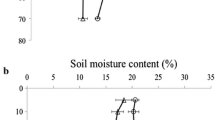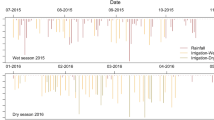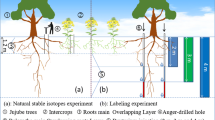Abstract
Intercropped trees are becoming popular as an ecological protection screen for a desert oasis from wind-blown sand and sand erosion. However, trees also consume a large amount of water and thus could compete for water resources with other crops. Here, we evaluated the water uptake in a typical alley cropping system within an oasis of the South Taklimakan desert. The system consisted of a poplar tree (Populus L.) used for sand protection and a walnut (Juglans regia L.)-corn (Zea mays Linn.) intercropping system. We evaluated root distribution by isotopically-labeled water (δD) and water uptake (δ18O) via SIAR models as well as the direct inference approach for different periods after tracer injection. We found that the different plants used water from different soil layers. While corn used water mostly from the 0–40 cm soil layer during the jointing (61%) and silking–filling periods (58%), respectively, walnut used water mostly from deeper than 40-cm depth (65%), and poplar used water from both shallow (about 30%, 0–40 cm) and deep soil layers (about 40%, 140–200 cm). Furthermore, while walnut roots can reach 200-cm depth, poplar roots can reach down to 400-cm depth. Due to those root differences, we infer that poplar trees do not necessarily compete for water resources with walnut and corn, and, therefore, can provide a valuable ‘safety-net’ service in this alley cropping system.








Similar content being viewed by others
References
Akinnifesi FK, Kang BT, Ladipo DO (1998) Structural root form and fine root distribution of some woody species evaluated for agroforestry systems. Agrofor Syst 42:121–138
An GX, Zeng FJ, Sun XW, Liu B, Liu Z, Zhang XL (2010) Soil water conditions under various vegetations in Southern fringe of Taklimakan Desert. Bull Soil Water Conserv 31(01):63–67
Bâ AM, Diédhiou AG, Prin Y, Galiana A, Duponnois R (2010) Management of ectomycorrhizal symbionts associated to useful exotic tree species to improve reforestation performances in tropical Africa. Ann For Sci 67:301
Beyer M, Koeniger P, Gaj M, Hamutoko JT, Wanke H, Himmelsbach T (2016) A deuterium-based labeling technique for the investigation of rooting depths, water uptake dynamics and unsaturated zone water transport in semiarid environments. J Hydrol 533:627–643
Buresh RJ, Rowe EC, Livesley SJ, Cadisch G, Mafongoya P (2004) Below ground interactions in tropical agroecosystems: concepts and models with multiple plant components. CABI Publishing, Wallingford
Caldwell MM, Dawson TE, Richards JH (1998) Hydraulic lift: consequences of water efflux from the roots of plants. Oecologia 113:151–161
Cannell MGR, Noordwijk MV, Ong CK (1996) The central agroforestry hypothesis: the trees must acquire resources that the crop would not otherwise acquire. Agrofor Syst 34:27–31
Cardinael R, Mao Z, Prieto I, Stokes A, Dupraz C, Kim JH, Jourdan C (2015) Competition with winter crops induces deeper rooting of walnut trees in a Mediterranean alley cropping agroforestry system. Plant Soil 391(1–2):219–235
Chen Y, Cui W, Li W, Chen Y, Zhang H (2003) Utilization of water resources and ecological protection in the Tarim River. Acta Geogr Sin 58(2):215–222
Chimner RA, Cooper DJ (2004) Using stable oxygen isotopes to quantify the water source used for transpiration by native shrubs in the San Luis Valley, Colorado U.S.A. Plant Soil 260:225–236
Dai Y, Zheng X-J, Tang L-S, Li Y (2014) Stable oxygen isotopes reveal distinct water use patterns of two Haloxylon species in the Gurbantonggut Desert. Plant Soil 389:73–87
Droppelmann KJ, Lehmann J, Ephrath JE, Berliner PR (2000) Water use efficiency and uptake patterns in a runoff agroforestry system in an arid environment. Agrofor Syst 49:223–243
Duan ZP, Gan YW, Wang BJ, Hao XD, Xu WL, Zhang W, Li LH (2017) Interspecific interaction alters root morphology in young walnut/wheat agroforestry systems in northwest China. Agrofor Syst 93(2):419–434
Ehleringer JR, Phillips SL, Schuster WSF, Sandquist DR (1991) Differential utilization of summer rains by desert plants. Oecologia 88:430–434
Evaristo J, McDonnell JJ, Clemens J (2017) Plant source water apportionment using stable isotopes: a comparison of simple linear, two-compartment mixing model approaches. Hydrol Process 31(21):3750–3758
Everson CS, Everson TM, Niekerk WV (2009) Soil water competition in a temperate hedgerow agroforestry system in South Africa. Agrofor Syst 75:211–221
Feagin RA, Figlus J, Zinnert JC, Sigren J, Martínez ML, Silva R, Smith WK, Cox D, Young DR, Carter G (2015) Going with the flow or against the grain? The promise of vegetation for protecting beaches, dunes, and barrier islands from erosion. Front Ecol Environ 13:203–210
Gao L, Xu H, Bi H, Xi W, Bao B, Wang X, Chao B, Chang Y (2013) Intercropping competition between apple trees and crops in agroforestry systems on the Loess Plateau of China. PLoS ONE 8(7):e70739
Gui D, Lei J, Mu G, Zeng F (2009) Effects of different management intensities on soil quality of farmland during oasis development in southern Tarim Basin, Xinjiang, China. Int J Sustain Dev World Ecol 16:295–301
Jackson PC, Meinzer FC, Bustamante M, Goldstein G, Franco A, Rundel PW, Caldas L, Igler E, Causin F (1999) Partitioning of soil water among tree species in a Brazilian Cerrado ecosystem. Tree Physiol 19:717–724
Jonsson K, Fidjeland L, Maghembe JA, Högberg P (1988) The vertical distribution of fine roots of five tree species and maize in Morogoro, Tanzania. Agrofor Syst 6:63–69
Kroon HD, Mommer L, Nishiwaki A (2003) Root competition: towards a mechanistic understanding. APS division of atomic. Root Ecol 2003:215–234
Kulmatiski A, Beard KH, Verweij RJ, February EC (2010) A depth-controlled tracer technique measures vertical, horizontal and temporal patterns of water use by trees and grasses in a subtropical savanna. New Phytol 188(1):199–209
Laboski CAM, Dowdy RH, Allmaras RR, Lamb JA (1998) Soil strength and water content influences on corn root distribution in a sandy soil. Plant Soil 203:239–247
Lehmann J (2003) Subsoil root activity in tree-based cropping systems. Plant Soil 255:319–331
Lin G, Sternberg LDSL (1993) Hydrogen isotopic fractionation by plant roots during water uptake in coastal wetland plants. Academic Press, London, pp 497–510
Link CM, Thevathasan NV, Gordon AM, Isaac ME (2012) Determining tree water acquisition zones with stable isotopes in a temperate tree-based intercropping system. Agrofor Syst 89:611–620
Livesley SJ, Gregory PJ, Buresh RJ (2000) Competition in tree row agroforestry systems. 1. Distribution and dynamics of fine root length and biomass. Plant Soil 227:149–161
Maeght JL, Rewald B, Pierret A (2013) How to study deep roots—and why it matters. Front Plant Sci 4(299):001–014
Mcdonnell JJ (2014) The two water world hypothesis: ecohydrological separation of water between streams and trees? Wiley Interdiscip Rev Water 1:323–329
Mulatya JM, Wilson J, Ong CK, Deans JD, Sprent JI (2002) Root architecture of provenances, seedlings and cuttings of Melia volkensii: implications for crop yield in dryland agroforestry. Agrofor Syst 56:65–72
Mulia R, Dupraz C (2006) Unusual fine root distributions of two deciduous tree species in southern France: what consequences for modelling of tree root dynamics? Plant Soil 281:71–85
Ning SL, Zhu JJ, Ling YQ (2009) Review on the shelter forest decline. Chin J Ecol 28:1684–1690
Noordwijk MV, Lawson G, Hairiah K, Wilson J (2015) Root distribution of trees and crops: competition and/or complementarity. Tree–crop interactions: agroforestry in a changing climate. CABI, Wallingford, pp 221–257
Parnell AC, Inger R, Bearhop S, Jackson AL (2010) Source partitioning using stable isotopes: coping with too much variation. PLoS ONE 5:e9672
Penna D, Hopp L, Scandellari F et al (2018) Ideas and perspectives: tracing ecosystem water fluxes using hydrogen and oxygen stable isotopes—challenges and opportunities from an interdisciplinary perspective. Biogeosciences 15(21):6399–6415
Ping FZ, Hui ZD, Zhu JJ, Qi JF, Xiao YX (2002) Advance in characteristics of ecological effects of farmland shelterbelts. J Soil Water Conserv 16:121–130
Plante PM, Rivest D, Vézina A, Vanasse A (2014) Root distribution of different mature tree species growing on contrasting textured soils in temperate windbreaks. Plant Soil 380:429–439
Puri S, Singh V, Bhushan B, Singh S, Puri S, Singh V, Bhushan B, Singh S (1994) Biomass production and distribution of roots in three stands of Populus deltoides. For Ecol Manage 65:135–147
Rothfuss Y, Javaux M (2017) Reviews and syntheses: isotopic approaches to quantify root water uptake: a review and comparison of methods. Biogeosciences 14:2199–2224
Ryszkowski L, Kędziora A (2007) Modification of water flows and nitrogen fluxes by shelterbelts. Ecol Eng 29:388–400
Stone EL, Kalisz PJ (1991) On the maximum extent of tree roots. For Ecol Manag 46:59–102
Sun SJ, Meng P, Zhang JS, Wan X (2011) Variation in soil water uptake and its effect on plant water status in Juglans regia L. during dry and wet seasons. Tree Physiol 31:1378–1389
Udawatta RP, Adhikari P, Senaviratne GMMMA, Garrett HE (2015) Variability of soil carbon in row crop watersheds with agroforestry buffers. Agrofor Syst 89:37–47
Wang P, Song XF, Han DM, Zhang YH, Liu X (2010) A study of root water uptake of crops indicated by hydrogen and oxygen stable isotopes: a case in Shanxi Province, China. Agric Water Manag 97:475–482
Woodall GS, Ward BH, Turner NC, Ward PR (2007) Soil water relations, crop production and root pruning of a belt of trees. Agric Water Manag 53:153–169
Wu J, Liu W, Chen C (2016) Below-ground interspecific competition for water in a rubber agroforestry system may enhance water utilization in plants. Sci Rep 6:19502
Zhang W, Ahanbieke P, Wang BJ, Gan YW, Li LH, Christie P, Li L (2015) Temporal and spatial distribution of roots as affected by interspecific interactions in a young walnut/wheat alley cropping system in northwest China. Agrofor Syst 89:327–343
Zhang W, Wang BJ, Gan YW, Duan ZP, Hao XD, Xu WL, Lv X, Li LH (2016) Competitive interaction in a jujube tree/wheat agroforestry system in northwest China’s Xinjiang Province. Agrofor Syst 91:881–893
Zhao Y, Zhang B, Hill R (2012) Water use assessment in alley cropping systems within subtropical China. Agrofor Syst 84:243–259
Acknowledgements
This work was financially supported by the National Talents Program (Y472241001), Strategic Pioneer Science and Technology Project of the Chinese Academy of Sciences (Category A) “Ecological Construction Model and Demonstration Project in Population Agglomeration Area” (XDA23060203), and Taishan Scholars Program (201812096). The authors would like to thank Markus Flury from Washington State University for the paper revision, Chengdao Li for help with data collection and the Cele Ecological Research Station for field and laboratory assistance.
Author information
Authors and Affiliations
Corresponding author
Additional information
Publisher's Note
Springer Nature remains neutral with regard to jurisdictional claims in published maps and institutional affiliations.
Rights and permissions
About this article
Cite this article
Guo, H., Zhao, Y. Using isotopic labeling to investigate root water uptake in an alley cropping system within Taklimakan Desert Oasis, China. Agroforest Syst 95, 907–918 (2021). https://doi.org/10.1007/s10457-020-00527-0
Received:
Accepted:
Published:
Issue Date:
DOI: https://doi.org/10.1007/s10457-020-00527-0




